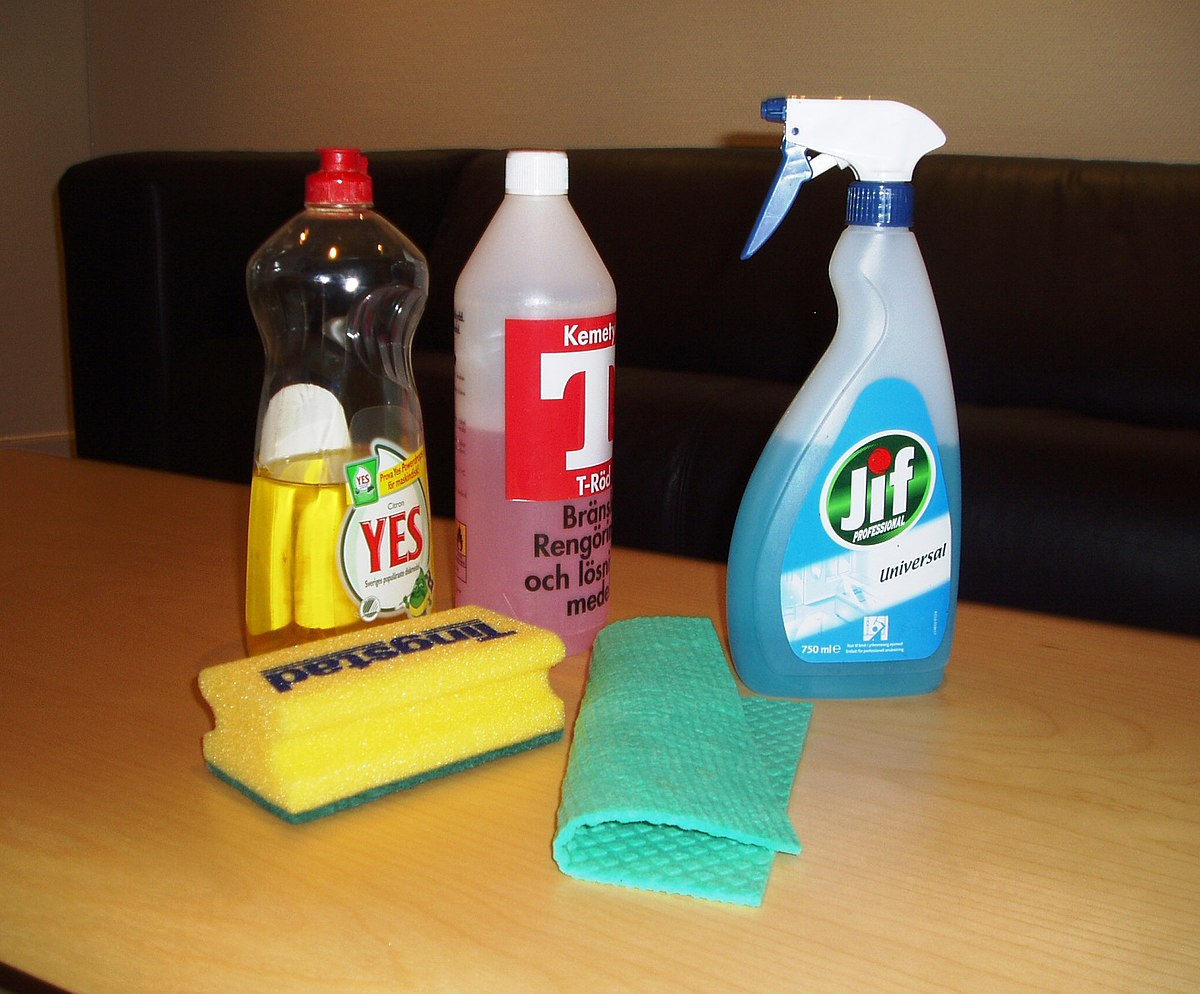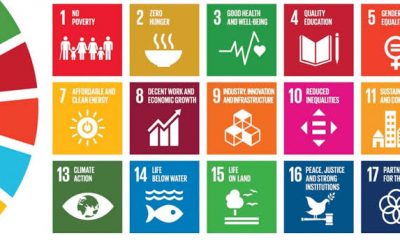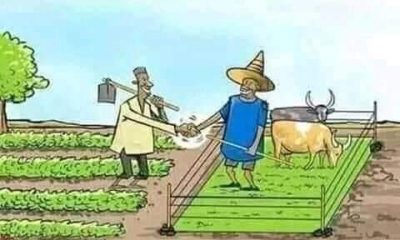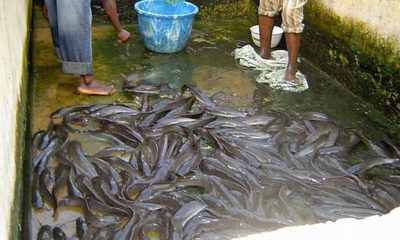Food Security
Bee keeping Farming in Africa: Honey Making

… @WufasAgronet, we don’t know more than food.
We earned the ‘FAO’ Top Fan barge.
The rearing of bees (apiculture) is basically for the production of honey, wax, and propolis. Some African communities keep bees for the sole purpose of providing security to their homesteads and farms.
Bee keeping was initially perceived as a traditional enterprise commonest among the hunters . The animals were considered wild where they scavenged for their own feed away from their shelter (open space on tree branches, in underground holes/caves atc).
Bee colonies on tree branches
With current innovations in agricultural sector, bee keeping is becoming a large scale venture and it has proved to have a much significant role in addressing the issue of food security and income sustainability. For instance, research has proved that bees play a very crucial role in pollination of the crops and this is important for agricultural crop yields.
The invention efforts have been geared towards changing the perception that bees are wild insects and cannot be farmed just like any other conventional animal.
Starting bee keeping
Just as many other enterprises, it is important to do valuation for the suitability/viability of the enterprise before investing your cash, time and effort.
Among the important factors to consider are together with:
Bees availability
This is the question of the ecological conditions of the place. Bees will prefer some places from the others for instance Adamawa regions and oku locality in North West Cameroon have proven to be very fertile.. The factors of great concern are temperatures, humidity and rainfall which will determine the availability of important resources like water and feed. The simplest method to populate the hives is by the use of the catcher boxes which are put in the path of the swarming bees to attract them. Some honey combs can be put into this boxes to lure the bees into the catcher box.
Capital
One has to determine if he/she has the required amount to start bee keeping. This is in terms of the cash for the purchase of the equipment like bee hives, catcher boxes, artificial feeds, labour, power honey comb spinners, smokers and all related cost.
We always recommend that the farmer should consider starting small and make use of locally available material. This will minimize on the cost and ensure good returns to a growing farmer.
Site selection
Siting the apiary is very important to a bee keeper to minimize the conflict between these animals and the famer/public/other animals. Below is an outline of the important considerations when siting an apiary:
The apiary should be away from noisy places like near a working machine. Noise excites bees and motivates them to sting.
Site the apiary at the place far from homestead and the animal yards/grazing areas. Site the bee hives closer to watering and foraging points. This will minimize the distance travelled to look for feed and water and the same is converted to productivity
Avoid situating hives closer to the busy roads/paths. Bees are easily disturbed by strong wind and air current. Avoid siting the hives directly facing the wind direction.
Site the hives at a point that makes supervision easy for the farmer/manager.
Make provisions to minimize the chances of predation to the bees. Most bee farmers are using the wire mesh to enclose the area so as to keep away birds and animals that prey on bees. You can as well use scare crows to keep in check the predators
Market for the final products
Every farmer wants to get the profit at the end of his/her labour. This is only attainable if the market for the final products is very much known and well organized. Considerations has to be made on how easy it will be to transport the inputs to the farm and the produce to the market.
The farmer has to understand what are the legal policies affecting the market for the products. How is the product affected by the forces of demand and supply in the final market? This determines the amount of the profit one can realize from it all.
Social and cultural considerations
It is important to understand the cultural believes of the people you target as the final market. For instance say a farmer wants to keep bees for honey among the people who believe honey is a product from insects and they are not interested to feed on such, it won’t work for this farmer to achieve the goals. But in a Muslim community it would be easier since honey is being cited in the sunnah as a powerful drug.
Bee is a social insect and will prefer living in a family like structure we are calling a colony. Each single bee colony can be made up of up to 3000-9000 bees or even more depending on the availability of the water and feed material around. The largest proportion of this is the worker bees (about 90% of the colony).
Subscribe on Agro-food FM.
For all follow up and advices in the domain of agriculture and food processing contact us
+237 678135708/ 655645780
We’re at bekoko Douala Cameroon.
A group of Agro-Food processing engineers
Our website
https://agro-foodfm.com/bee-farming-in-africa/
honey
agrofood
Douala
Food Security
CHARACTERISTICS OF GOOD DETERGENT

CHARACTERISTICS OF GOOD DETERGENT
www.wufasagronet.com
….. @WufasAgronet, we are Food Security (processing) Advocates.
✅Earned FAO, WFP, WORLD BANK, IFAD, IDA, IMF, UNSDGs, USAID, ROCKEFELLER FOUNDATIONS, BBC NEWS, JAGABAN ARMY, PUNCH NEWSPAPERS, GUARDIAN Newspapers, Today Reporters, Ripples News etc TopFan Barges.
✅Member NAAJ, PAAJ, IFAJ AND AFAN.
✅Consultancy Services in Human Capital and Value Chain Development in Food Processing technology.
DETERGENTS used for washing in industries should have the following characteristics.
-Ability to loosen organic matters eg. Soil etc. (organic dissolving power)
-Good rinsing power.
-Adequate wetting power to allow detergent to penetrate the deposit acting quickly and efficiently.
-Good sequestering power – removal of mineral deposits eg. Calcium, magnesium.
-Emulsifying power – fragmenting oil into tiny particles.
-Adequate germicidal power to sterilized dirty detergent solutions.
-Ability to dissolve alkali solutions precipitate of calcium and magnesium salt.
-It should not be corrosive.
-It should posses good buffering and saponifying powers.
The above characters may not be contained in a single detergent but if blended with others rich in some of the characters, a good result may be achieved.
MAJOR SOURCES OF DETERGENTS.
{Alkalis} – Caustic soda is the basic ingredient of detergent however,
there could be addition of other additives to give a property to the detergent. Other basic ingredients are Soda ash, Sodium silicate and others as seen above.
SEQUESTERING AGENT.
This is the action of polyphosphate in precipitation of calcium and magnesium salts in water creating additional wetting agent and polyphosphate to assist sequestration this would constitute most effective and economical clean-in-place detergent for brewing cleanings.
WETTING AGENT.
Known generally as synthetic detergent, Wetting agents are classified into 3 major types :An-ionic and Cat-ionic wetting agents.
The An-ionc type is commonly used for detergent formulation eg. Sulphated alcohols alkyl or aryl sulphonates. Non-ionic are mostly the polyethylonic oxide. On blending of both an ionic and catonic the result may be excessive foaming. It also processes good wetting, dispersing and rinsing power.
STERILISING AGENT.
Alkalis porcess sterilizing power, which increases with pH and temperature.
At WufasAgronet, we are competent and reliable Food Technologists into Human Capital and Value Chain Development Consultancy in Food Processing. Contact us email :wufasagronet@gmail.comPls go through the earlier sent documents.
Food Security
SEASONINGS. FLAVORS. FOOD INGREDIENTS.

✔Contact us @WufasAgronet for wide range of integrated flavors and seasonings, we are Manufacturers’ Representative.
…. @WufasAgronet we are Food Security (Processing) Advocates.
✅Earned FAO, WFP, WORLD BANK Group, UNSDGS, ROCKEFELLER FOUNDATIONS, BBC NEWS, JAGABAN ARMY, PUNCH NEWSPAPERS, GUARDIAN Newspapers, Today Reporters, Ripples News, etc TopFan Barges.
✅Member NAAJ, PAAJ, IFAJ & AFAN.
✅CONSULTANCY SERVICES IN HUMAN CAPITAL AND VALUE CHAIN DEVELOPMENT IN FOOD PROCESSING.
✔FLAVORS
BAKERY & PASTRY FLAVORS
*Vanilla flavor
*Condensed milk flavor
*Butter scotch flavor
*Enzyme chocolate flavor
*Enzyme butter flour
*Milk flavor
*Coconut flavor
✔ CONFECTIONERY & CANDY FLAVORS
*Strawberry flavor
*Chocolate flavor
*Orange flavor
*Butter vanilla flavor
*Banana flavor
*Mango flavor
*Lemon flavor
*Milk flavor
*Vanilla flavor
*Apple flavor
*Mixed berry flavor
*Coconut flavor
*Caramel flavor
*Honeydew flavor
*Condensed milk flavor
*Peanut flavor
*Cheese flavor
✔BEVERAGE FLAVORS
*Apple flavor
*Coconut flavor
*Caramel flavor
*Mango flavor
*Lemon flavor
*Banana flavor
*Pineapple Flavor
*Orange flavor *Strawberry flavor
*Natural Ginger flavor
*Malta flavor
*Grape flavor
*Raspberry flavor
✔ENCAPSULATED FLAVORS
*Strawberry flavor
*Raspberry flavor
*Mixed Berry flavor
*Orange flavor
*Apple flavor
*Banana flavor
✔BEVERAGES (CONCENTRATES, COMPOUNDS, BASES AND EMULSIONS) :
*Pineapple
*Lemon
*Ginger
*Cola
*Black currant
*Orange
*Strawberry
*Chapman
*Apple
*Banana
*Mixed fruit
*Cocopina
✔SAVOURY FLAVORS
*Beef flavor
*Chicken flavor
*Tomato flavor
*Cheese flavor
*Seafood flavor
*BBQ flavor
*Roasted flavor
*Smoked fish flavor
*Suya flavor
*Peanut flavor
*Roasted Chicken flavor
*Sardine flavor
*Smoke flavor
✔MILK POWDER :
*Fat filled milk powder
*Skimmed milk powder
*Full cream powder
*Flavored milk powder
*Butter milk powder
✔ICE-CREAM, YOGHURT & DAIRY FLAVORS :
*Yogurt flavor
*Vanilla flavor
*Strawberry flavor
*Banana flavor
*Mixed Berry flavor
*Chocolate flavor
*Cherry flavor
*Mango flavor
✔SEASONINGS:
FOOD SEASONINGS
*Beef seasoning
*Chicken seasoning
*Tomato seasoning
*Cheese seasoning
*BBQ Seasoning
*Seafood seasoning
*Noddles seasoning
*Pasta seasoning
*Jollof seasoning
✔SPICES :
*Cinnamon powder
*Onion powder
*Ginger powder
*Garlic powder
*Paprika powder
*Nutmeg powder
✔FOOD INGREDIENTS :
*Fat Replacer (Handisol – 25)
*Sweetener
✅OTHERS :
*Real meat reaction pastes
*Vegemeat for sausage roll
*Spice flavor oil
*Liquid and oil soluble flavor
*Soup and gravy mixes
*Ice cream premix
*BBQ sauce
*Tomato /Pizza sauce etc.
At WufasAgronet , we are competent and reliable Food Technologists into Human Capital and Value Chain Development Consultancy in Food Processing technology training the teeming youthful population including teirary institutions graduates in Global Competitiveness and International Best practices in Food Processing technology.
Contact email wufasagronet@gmail.com
Food Security
SECURITY PATHWAYS IN RELATION TO SUSTAINABLE FOOD SECURITY OF A NATION.

Good governance is predicated on ensuring the actualisation of the various security architecture of a Nation. The political barometer is also monitored through the efficiency of the security pathways which are :
INTERNAL SECURITY, INFORMATION/COMMUNICATION. , FOOD SECURITY, HEALTH ,EDUCATION, ELECTRICITY, TRANSPORTATION AND INDUSTRIAL GROWTH.
.
All the above are the essential security systems that can produce and provide QUALITY POPULATION through good and quality SUPERVISION
✅NATIONAL Security of life and properties is the (numero uno) number one responsibility of the Head of government be it President, Head of state and others. The mandate to secure life and property is paramount , they control and command the apparatus of security such as adequate Policing, effective Armed forces- Army for protection against external or internal aggression. Customs / Immigration for vigilant boarders patrol to prevent smuggling and immigration control amongst many others . Equipping them with weapons, Aircrafts, Vehicles, Boats etc.
For effective surveillance. In tackling the menace of bandits and kidnappers who have taken over the forest prohibiting farming activities . Armed Forest Guards / Rangers should be introduced.
INFORMATION/COMMUNICATION.
The entire world is in information age.
The constitution clearly stipulate that every person shall be entitled to freedom of expression, freedom to hold opinions and to receive as well as to impact ideas and information.
However, it is the opinion of this writer that freedom be guided with secured intent to prevent abuse that may result in conflicts and war through hateful and unguided utterances.
The most acceptable form of communication is such that promote humane, responsible and patriotic reportage upholding the concept of discipline and promoting values nationally and internationally.
A lot of opportunity mostly untapped abound for investment in Information and communication like Print, Electronic and ICT media.
For industrial growth, information through advertisement, publication and social media is vital for public awareness.
FOOD SECURITY
Whether one eat to live or live to eat is a matter of semantics the bottom – line is Food is the main sustainace of bodies and souls. The importance of food cannot be over emphasised . knowing this fact of life has made the developed world to appropriately plan for provision of quality food for their citizens. Provision of food is prioritize in their national agenda. It is on this note that the United Nation’s clarion call to others in the world to emulate the culture of Sustainable Food Security ensuring the Tripple A(s). of AVAILABILITY, ACCEPTABLITY and AFFORDABILITY. ( UN 2030 food security agenda) of good quality food for the underdeveloped countries who are import dependent on basic food items such as Rice, Sugar, Dairy , Beverages etc .
Presently, Nigeria is revolutionising agrioprenuerial activities, it’s hoped that the present policies on agriculture will not be Summersaulted. The Maputo declaration on allocation of minimum 10% of the country’s annual budget must go to agriculture. Food must be made a constitutional right for all. The authority must take time to support Micro and Small scale Agroprenuerails activities to adapt to climate change. Agroprenuerail activities is the surest way to lift hundreds of millions out of hunger, poverty, conflict and deaspiration.
HEALTH CARE
Health is wealth – Primary Health care delivery must be taken to the grassroot levels, while Rural Health care moblisation be made available and effective all must be well equipped with vaccines, drugs, consumables and other biologicals.
— Ensure maintenance of standard by private sector through effective monitoring.
— Tapping into Herbs Processing , local medical herbs be Researched into by National Institute of Pharmaceutical RnD. In Collaboration with Fed Mins. of Science and Technology.
— Integration of alternative medicine into health care.
— Health insurance scheme must be intensified on .
— Stemming of illegal importation of smuggled fake drugs and illegal drug manufacturing in the country.
EDUCATION
A Society, Community and Nation is as good as the percentage of her literary population. The various levels of education are Primary , Secondary and teriary education 6-3-3-4 .Education must attract appropriate budget at all time. Education is being administered by Public and Private participation at all levels. The special education must receive attention by provision of special equipment such as braille machine, audiometer etc.
ELECTRICITY
To the chagrin of the unsuspecting consumers and Contrary to claim of the generation companies that generation capacity has improved to 7000 MW , the actual has been fluctuating between 2500 -3500 MW.(April 2019)
The idea of mono grid must be jettison while the legislation be relaxed to accommodate Private participations in generation. While effort must be intensified on the Green Bond of #10.97bn raise in December 2018. for financing of SOLAR energy.
Industrial development is unachievable without steady supply of electricity. A green belt of
Industrial Parks on Green energy is recommended in all the States of federation.this will sustain industrial activities that will promote growth.
TRANSPORTATION
This sector is an indispensable catalyst for stimulating economic, social, political and strategic/defence development of a Nation. All the National Development plans must accord the transport sector very high priority. In the formulation of National Transport policy, there must be defined objectives such as economic efficiency and coordinated development plan.
All forms of transportation system are embraced in Nigeria. Motor ,Railway transportation, inland waterways, aviation terminal and handling facilities seaports, airports and riverports including other ancillary facilities.
The administration of Transportation is vested in both Fed. Ministry of Works and Housing (Fed. Highways – Interstate roads Construction and maintenance) and State Ministry of Works/Transport (interstate roads while LG is responsible for Urban and Rural roads Construction and maintenance.
Aviation Ministry for Civil Aviation, Airports Development Management and Metrological services.
Internationally, the railway system is more affordable and relatively saver the frequency in Nigeria must be upgraded not scanty show up as is now the case.
INDUSTRIAL GROWTH
The economic growth rate ( 2019) is 2.1% ,this development is not unconnected with the dismal performances of the various indices above. eg the manufacturing growth rate is presently less than 7% although the Fedreral government set a 10.6% goal in 2017.which was to be driven by SME. Productivity is the only stimulant for Industrial growth. Farming output is barely about 22% mostly subsistence. .about 55% of work force is absorbed by agriculture. The major farming communities in North East, Middle belt downwards to the southern section are being sacked either Boko Haram terrorist or Pasteuralist /Farmers conflicts and banditry.
The various activities as enumerated in this writeup are all depended on Food security system. FOOD SECURITY MUST BE IN THE FRONT BURNER TO ACHIEVE SUCCESS. IN OTHER SEGMENTS.
CONCLUSION
— FOOD Security issues must be in the front burner of government’s agenda. Since it encompasses all other activities.
— The effectiveness of other parasatal must be ensured through adequate supervision.
— TO PREVENT IMMINENT DANGER OF FAMINE. Forest Guards (armed) must be appropriately deployed to secure the large expanse of the forest for Farming activities.
— Indigenous Reserch and Development on local Technology be improved on.
— Electricity generation from Green Energy source should be encouraged in the Industrial parks.
— Food Security system must be made a CONSTITUTIONAL RIGHT for all the citizenry.
At WUFAS AGR0Net, we are Competent and Reliable Food Processing Technologists ,into Human Capital Development Consultancy. Centering on ETHICS of Food Processing Technology. Training on industrial food processing (General Manufacturing Principles ) to the teeming youthful population, startups and other Food handlers. We are seeking Collaboration and Strategic partnership with corporate bodies, NGOs and others
Interested in Food Security.
Contact: 08157784430, 08034064270.
Emails wufasagronet @gmail.com
-

 Environmental3 years ago
Environmental3 years agoOPINION: AN ACCESSMENT OF NIGERIA’S PERFORMANCE IN THE OPTICS OF THE UN 17 SUSTAINABLE DEVELOPMENT GOALS AGENDA 2030. ( Periodic quaterly review & update — ( September ’22)
-

 Food Security3 years ago
Food Security3 years agoREALITIES OF LARGE SCALE INTEGRATED AGROPRENUERAIL FARMING AND FOOD PROCESSING BUSINESS IN NIGERIA. (Update)
-

 Food Security4 years ago
Food Security4 years agoEXCITING FACTS ABOUT RANCHING
-

 Food Security3 years ago
Food Security3 years agoTOP SEVEN AGRICULTURAL COMMODITIES WITH HUGE UNTAPPED POTENTIALs – update
-

 Food Security4 years ago
Food Security4 years agoMITIGATING THE MENACE OF CLIMATE CHANGE THROUGH GREENBOND ISSUANCE.
-

 Food Security3 years ago
Food Security3 years agoFISH PROCESSING TECHNOLOGY
-

 Food Security4 years ago
Food Security4 years agoTHE ROLE OF E -COMMERCE IN SYNERGISING AGRICULTURAL VALUE CHAIN DEVELOPMENT IN AFCTA IS SINE QUA-NON.
-

 Food Security3 years ago
Food Security3 years agoTHE IMPENDING GLOBAL FAMINE FROM THE PERSPECTIVES OF THE WORLD INSTITUTIONAL LEADERS.
